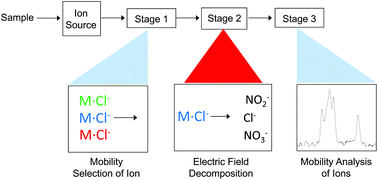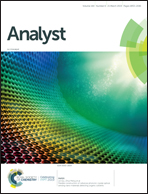Tandem ion mobility spectrometry at ambient pressure and field decomposition of mobility selected ions of explosives and interferences†
Abstract
A tandem ion mobility spectrometer at ambient pressure included a thermal desorption inlet, two drift regions, dual ion shutters, and a wire grid assembly in the second drift region. An ion swarm could be mobility isolated in the first drift region using synchronized dual ion shutters and decomposed in a wire grid assembly using electric fields of 1.80 × 104 V cm−1 (118 Td) from a 1.8 MHz sinusoidal waveform. Mobility selected ions that underwent field induced decomposition were NO3−, from PETN·Cl− and NG·Cl−, and NO2− from RDX·Cl−. The extent of decomposition ranged from 60 to 90%, depending on gas temperature, field strength, and ion identity, introducing additional controls to improve selectivity in trace determination of explosives. Ion transmission through the wire grid assembly ranged from 80 to >95% with losses increasing for increased field strength. Studies with pairs of explosives and interfering substances demonstrated decisive detection of explosives and portend reduced rates of false positive using tandem ion mobility spectrometers with a reactive stage.



 Please wait while we load your content...
Please wait while we load your content...